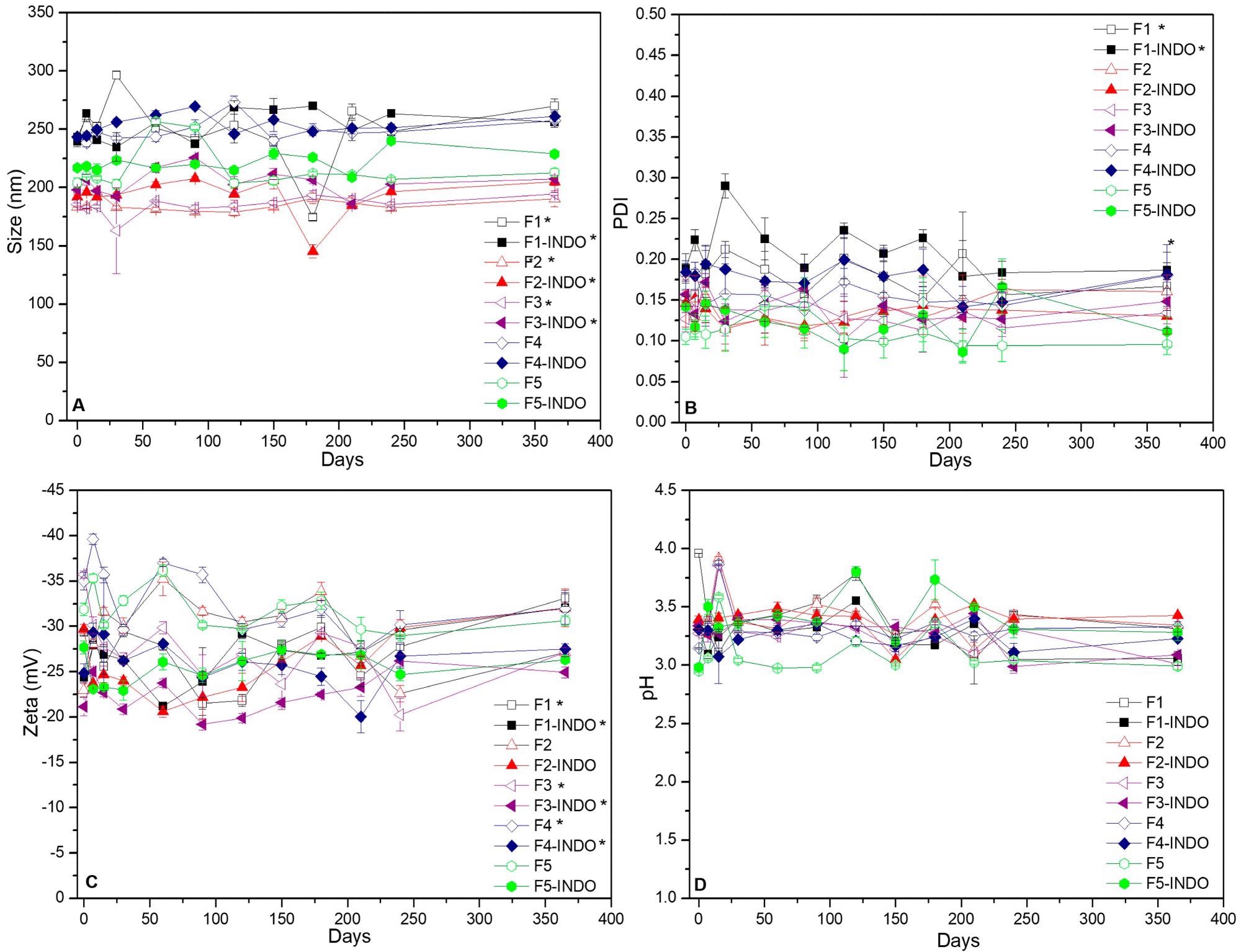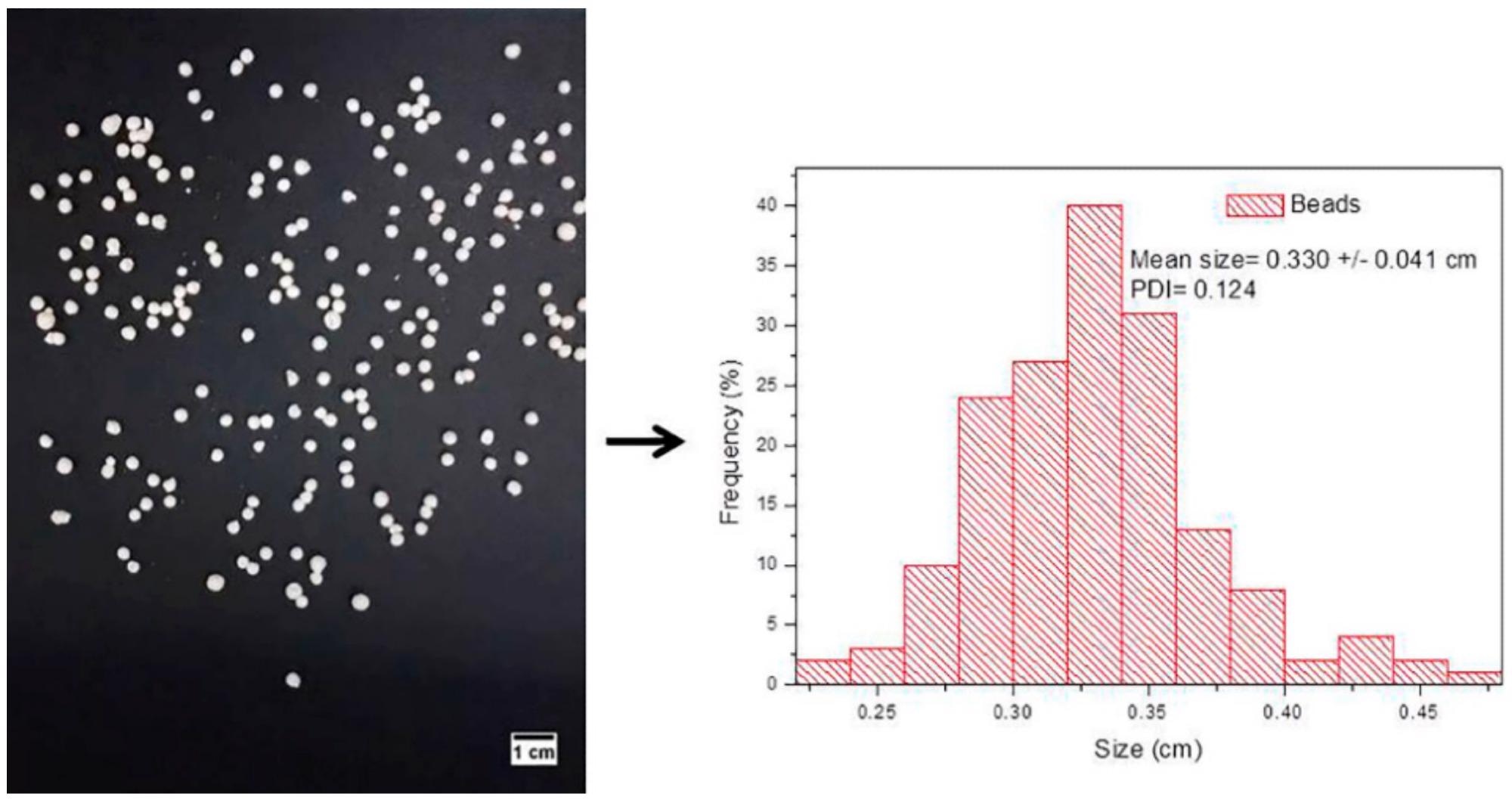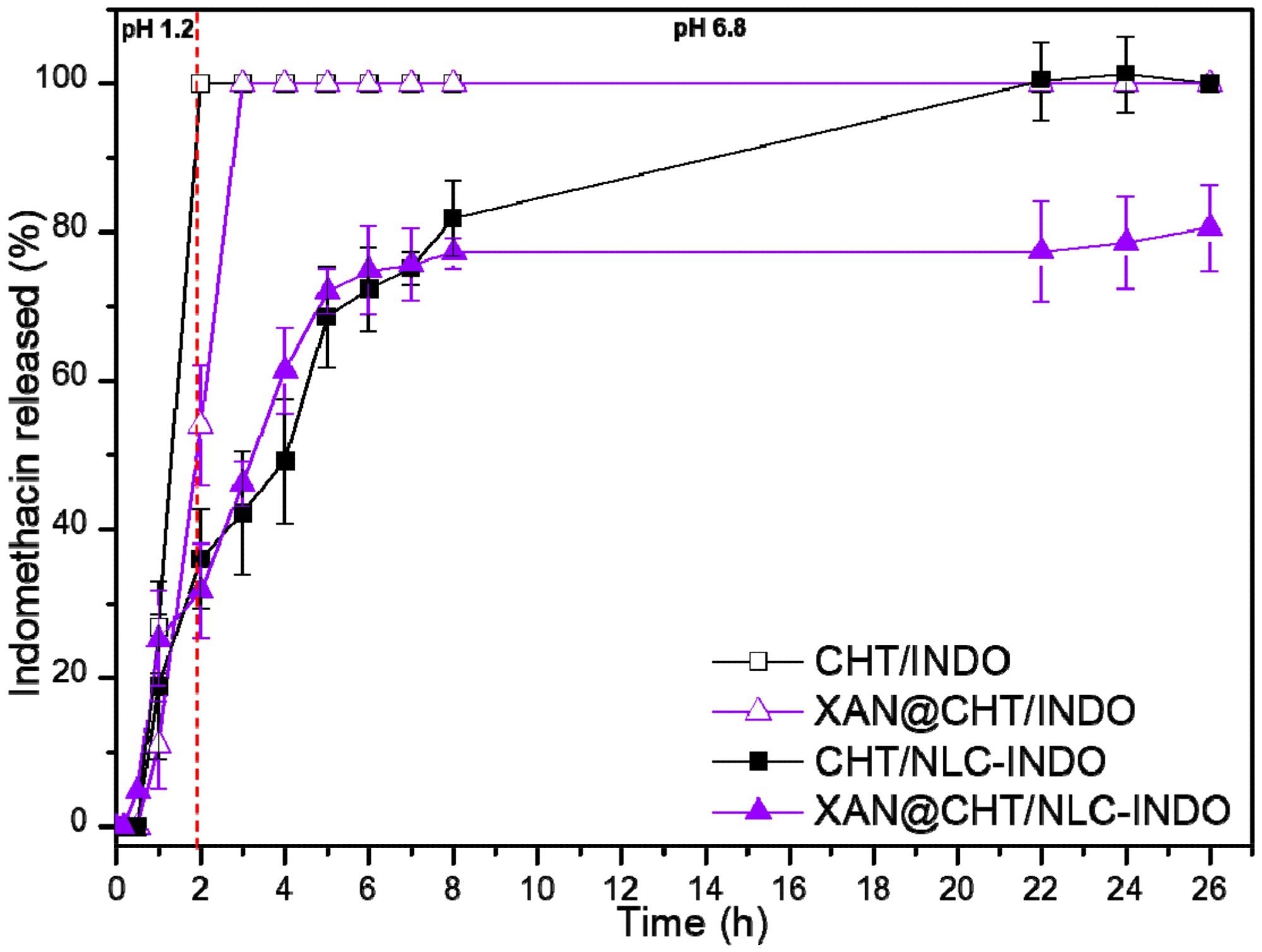A group of researchers recently published a paper in the MDPI journal pharmaceutics that demonstrated the effectiveness of using lipid-biopolymer nanobeads as indomethacin (INDO) carriers to reduce drug toxicity.
Background
INDO, an orally administered non-steroidal anti-inflammatory (NSAID) agent, is used extensively for inflammation, fever, and pain control. However, the oral administration of INDO often leads to severe side effects, specifically in the gastrointestinal system, such as abdominal ache, indigestion, and diarrhea owing to the first-pass metabolism. Thus, new approaches are being investigated to lessen the INDO systemic toxicity and improve its overall efficacy.

Figure 1. Long-term stability of NLC formulations, monitored in terms of size (A), PDI (B), Zeta potential (C) and pH (D) values for up to a year, at 25 °C (n = 3; p < 0.05). © Bonetti, F.M.R., de Paula, E., Fonseca, B.B. et al. (2022)
Colloidal drug delivery systems (DDS) with improved therapeutic actions can reduce the side effects by releasing the loaded drugs in a sustained manner. For instance, nanostructured lipid carriers (NLC) can be used to load and deliver various anti-inflammatory compounds through several drug administration routes. However, NLC as a colloid cannot provide the mucoadhesion and gastro-resistance required for oral administration of INDO.
Lipid–polymer nanohybrid formulations that contain at least a single nanostructured material in their composition can potentially merge the benefits of every excipient/carrier within a single DDS. Biopolymers are widely utilized as DDS as they are biodegradable, biocompatible, and versatile in nature. For instance, chitosan, a cationic polysaccharide, possesses exceptional mucoadhesive properties, which can be suitable for INDO administration.
However, chitosan displays sensitivity to acid media such as the gastric microenvironment. This issue can be resolved using xanthan gum (XAN), an anionic exopolysaccharide, as the coating agent of the lipid-polymer nanohybrid formulations such as nanobeads.
The Study
In this study, researchers combined two distinct strategies of coating and hybridization to decrease the INDO systemic toxicity and extend its release profile by simulating an oral administration. Initially, lipid–biopolymer nanobeads were synthesized in which NLC blended with chitosan solution encapsulated the INDO, and the nanobeads were coated by XAN. Later, they investigated the efficacy of the synthesized nanobeads and the reduction in INDO toxicity due to them.

Figure 2. Digital photo (left) of hybrid nanobeads (XAN@CHT/NLC-INDO) and particle size distribution (right), estimated by ImageJ software, (n = 3). © Bonetti, F.M.R., de Paula, E., Fonseca, B.B. et al. (2022)
3-(4,5-dimethylthiazol-2-yl)-2,5-diphenyltetrazolium bromide (MTT), chitosan, XAN, INDO, Pluronic® 68 (P68), poloxamer, myristyl myristate (MM), coconut oil (CO), and deionized (DI) water with 18 MΩ resistivity were used as the starting materials.
2%, w/v NLC/INDO and NLC as control formulation were synthesized by the ultrasonication emulsification method, where MM acted as a solid lipid, poloxamer as a surfactant, and CO as a liquid lipid. Under magnetic stirring, the lipid phase containing CO and MM was briefly heated without or with 2% INDO at 10oC above the solid lipid melting point.
The aqueous phase containing 2-5% P68 was also heated at a similar temperature and then added to the lipid phase under high-speed homogenization for 3 min at 10,000 rpm in an Ultra-Turrax blender. Eventually, the obtained microemulsion was tip-sonicated at 20 kHz and 500 W in 30 s (on/off) cycles for 20 min, and then cooled in an ice bath to 25oC.
The polydispersity index (PDI) and particle size of the synthesized NLC/INDO and NLC formulations were determined using the dynamic light scattering (DLS) method, while the Zetasizer Nano ZS90 equipment was employed to measure their zeta potential values by electrophoretic light scattering. Researchers also determined the long-term physicochemical stability and in vitro cell viability of the samples and the INDO encapsulation efficiency.
Chitosan was scattered in 50 mL of 0.1% acetic acid, and XAN was dissolved in 50 mL DI water under magnetic stirring. Subsequently, 2% hydroalcoholic INDO solution was mixed with the chitosan solution and stirred at room temperature for 2 h to obtain chitosan/INDO beads.
In the preparation of chitosan/NLC-INDO hybrid nanobeads, half of the acetic acid solution was replaced with NLC loaded with 2% INDO for chitosan solubilization. The final XAN-coated forms were synthesized by initially immersing the aliquots of chitosan/NLC-INDO nanobeads and chitosan/INDO beads into 0.5% w/v XAN aqueous solution, then filtering and cooling them to −20oC, and finally freeze-drying.
Researchers performed the water uptake test and the INDO release test in in vitro mode, and in vivo toxicity assays through the chicken embryo model on the samples.
Observations
Ten distinct NLC formulations without and with INDO were successfully synthesized that showed a pale white color and a homogenous aspect. The physicochemical properties of NLC formulations remained suitable for use even after one year of storage, which indicated their long-term stability, and their INDO encapsulation efficiency was 99%.
The hybrid nanobeads of XAN-coated chitosan and NLC/INDO displayed exceptional thermodynamic, structural, and in vitro swelling properties, which indicated excellent compatibility between the biomaterials, and an extended drug release profile up to 26 hours.

Figure 3. Indomethacin in vitro release from beads (CHT/INDO and XAN@CHT/INDO) and nanobeads (CHT/NLC-INDO and XAN@CHT/NLC-INDO), quantified by UV-vis (λ = 210 nm) at 37 °C, n = 5. © Bonetti, F.M.R., de Paula, E., Fonseca, B.B. et al. (2022)
The synergism observed between the biopolymer and nanolipid excipients helped in preventing the burst release effect within the first two hours of experiments, which simulated a gastric medium, followed by an extended-release in the pH 6.8, simulating an intestinal medium.
The XAN coating on nanobeads acted as a gastro-resistant excipient that protected chitosan and NLC/INDO from an unexpected swelling and prevented drug release in the initial hours of experiments.
The safety of the nanobeads was confirmed in the in vivo toxicity assay in chicken embryos (CE) as the combined benefits of coating and hybridization procedures reduced the inherent toxicity of INDO in chicken embryos.
Taken together, the findings of this study demonstrated that the lipid–biopolymer nanobead can be effectively used for delivering INDO, and other anti-inflammatories, through oral administration.
News
Platelet-inspired nanoparticles could improve treatment of inflammatory diseases
Scientists have developed platelet-inspired nanoparticles that deliver anti-inflammatory drugs directly to brain-computer interface implants, doubling their effectiveness. Scientists have found a way to improve the performance of brain-computer interface (BCI) electrodes by delivering anti-inflammatory drugs directly [...]
After 150 years, a new chapter in cancer therapy is finally beginning
For decades, researchers have been looking for ways to destroy cancer cells in a targeted manner without further weakening the body. But for many patients whose immune system is severely impaired by chemotherapy or radiation, [...]
Older chemical libraries show promise for fighting resistant strains of COVID-19 virus
SARS‑CoV‑2, the virus that causes COVID-19, continues to mutate, with some newer strains becoming less responsive to current antiviral treatments like Paxlovid. Now, University of California San Diego scientists and an international team of [...]
Lower doses of immunotherapy for skin cancer give better results, study suggests
According to a new study, lower doses of approved immunotherapy for malignant melanoma can give better results against tumors, while reducing side effects. This is reported by researchers at Karolinska Institutet in the Journal of the National [...]
Researchers highlight five pathways through which microplastics can harm the brain
Microplastics could be fueling neurodegenerative diseases like Alzheimer's and Parkinson's, with a new study highlighting five ways microplastics can trigger inflammation and damage in the brain. More than 57 million people live with dementia, [...]
Tiny Metal Nanodots Obliterate Cancer Cells While Largely Sparing Healthy Tissue
Scientists have developed tiny metal-oxide particles that push cancer cells past their stress limits while sparing healthy tissue. An international team led by RMIT University has developed tiny particles called nanodots, crafted from a metallic compound, [...]
Gold Nanoclusters Could Supercharge Quantum Computers
Researchers found that gold “super atoms” can behave like the atoms in top-tier quantum systems—only far easier to scale. These tiny clusters can be customized at the molecular level, offering a powerful, tunable foundation [...]
A single shot of HPV vaccine may be enough to fight cervical cancer, study finds
WASHINGTON -- A single HPV vaccination appears just as effective as two doses at preventing the viral infection that causes cervical cancer, researchers reported Wednesday. HPV, or human papillomavirus, is very common and spread [...]
New technique overcomes technological barrier in 3D brain imaging
Scientists at the Swiss Light Source SLS have succeeded in mapping a piece of brain tissue in 3D at unprecedented resolution using X-rays, non-destructively. The breakthrough overcomes a long-standing technological barrier that had limited [...]
Scientists Uncover Hidden Blood Pattern in Long COVID
Researchers found persistent microclot and NET structures in Long COVID blood that may explain long-lasting symptoms. Researchers examining Long COVID have identified a structural connection between circulating microclots and neutrophil extracellular traps (NETs). The [...]
This Cellular Trick Helps Cancer Spread, but Could Also Stop It
Groups of normal cbiells can sense far into their surroundings, helping explain cancer cell migration. Understanding this ability could lead to new ways to limit tumor spread. The tale of the princess and the [...]
New mRNA therapy targets drug-resistant pneumonia
Bacteria that multiply on surfaces are a major headache in health care when they gain a foothold on, for example, implants or in catheters. Researchers at Chalmers University of Technology in Sweden have found [...]
Current Heart Health Guidelines Are Failing To Catch a Deadly Genetic Killer
New research reveals that standard screening misses most people with a common inherited cholesterol disorder. A Mayo Clinic study reports that current genetic screening guidelines overlook most people who have familial hypercholesterolemia, an inherited disorder that [...]
Scientists Identify the Evolutionary “Purpose” of Consciousness
Summary: Researchers at Ruhr University Bochum explore why consciousness evolved and why different species developed it in distinct ways. By comparing humans with birds, they show that complex awareness may arise through different neural architectures yet [...]
Novel mRNA therapy curbs antibiotic-resistant infections in preclinical lung models
Researchers at the Icahn School of Medicine at Mount Sinai and collaborators have reported early success with a novel mRNA-based therapy designed to combat antibiotic-resistant bacteria. The findings, published in Nature Biotechnology, show that in [...]
New skin-permeable polymer delivers insulin without needles
A breakthrough zwitterionic polymer slips through the skin’s toughest barriers, carrying insulin deep into tissue and normalizing blood sugar, offering patients a painless alternative to daily injections. A recent study published in the journal Nature examines [...]





















